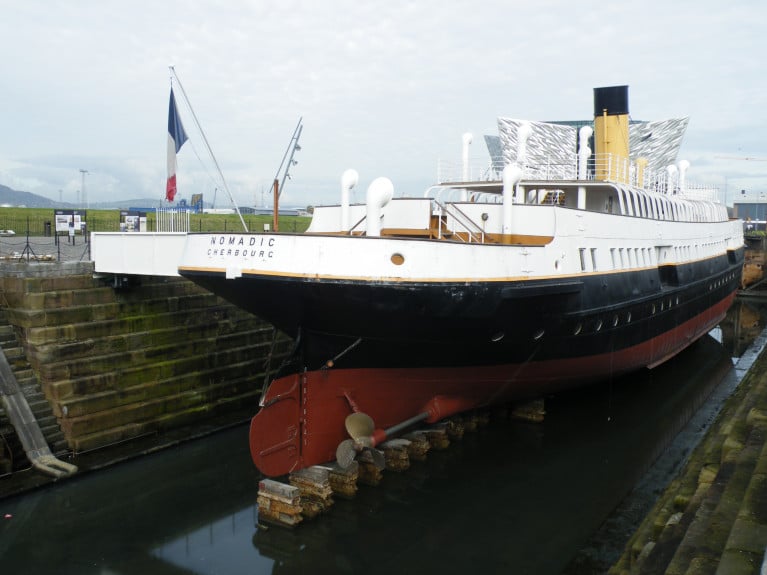Displaying items by tag: Dublin's 'Old' DryDocks
Maritime Heritage in NI Where SS Nomadic & Titanic Belfast Receive Covid Recovery Grants
The tender that served RMS Titanic at Cherbourg, France, which forms part of the liner's visitor attraction centre in Belfast Harbour, have both received £1.63m from a total £5m plus funding from the UK's Heritage Recovery Fund, writes Jehan Ashmore.
According to the National Historic Ships UK, the funding awarded to the tender SS Nomadic and Titanic Belfast, is to support the recovery and reopening of the centre, as well as protect the future of its heritage – a significant driver of global tourism and economic growth for Northern Ireland.
SS Nomadic, capable of 1,000 passengers, divided into three classes, was purpose built for the White Star Line and is the last remaining ship from the company, which highlights the historic story of Belfast’s maritime heritage and as the biggest Titanic artefact.
Designed and built by Harland and Wolff in 1910-11, the SS Nomadic has many of the same luxurious finishes as RMS's Titanic / Olympic, and is a quarter of the size. The tender was also designed to transport luggage and stores to and from the liners anchored offshore.
In addition the funding, totalling more than £5m was awarded to other heritage organisations including the National Trust NI and Creggan Country Park along with self-employed tour guides, stonemasons, coppersmiths and conservators.
The awards aim to safeguard jobs for the long-term and enable recipients to adapt and prepare for reopening or restarting work when restrictions permit.
“The risks to historic sites, attractions and essential heritage jobs and skills from a sudden and dramatic loss of income as a result of the pandemic, have put the heritage and visitor economy in crisis, and we hope this funding will play a vital role in their recovery,” states Paul Mullan, director, Northern Ireland, National Lottery Heritage Fund.
He added “Heritage has an essential role to play in making communities better places to live, creating economic prosperity and supporting personal wellbeing. All of these are going to be vitally important as we emerge from the current pandemic.”
SS Nomadic: Maritime 'Dry Docked' Heritage
Following the White Star career, SS Nomadic, saw active service in both World Wars as a troop carrier. Nomadic also tendered thousands of passengers to the world’s great liners also in Cherbourg, to serve the 'Cunarders' Queen Mary and Queen Elizabeth. This was followed with the tender becoming a Paris based restaurant and party venue on the bank of the River Seine.
Fortunes changed and the Nomadic relocated downriver, having languished for decades in Le Havre, when enthusiasts became aware of its plight, and began a campaign to ‘Save the Nomadic’ from scrappage. This ultimately led to the tender's towed return to Belfast and with shipyard origins where the veteran vessel underwent a major restoration project.
Find out more about the 'Shipshape' Network Northern Ireland zone 'here'.
Dublin's Grand Canal Dock (Basin) Graving Dry-Docks
As for Ireland's maritime heritage, Afloat previously reported last week, where in the case of Dublin, Waterways Ireland plan to sell off the historic graving dry-docks in the Grand Canal Basin. As also reported in 2016, the saved 'Georgian' dry-docks, along with a rare surviving historic Irish built ship, aptly constructed in the capital, Naomh Éanna remains in the larger dry-dock which links the Inland Waterways.
The former Aran Islands passenger, cargo and livestock ferry, was then also saved from scrapping following a petition. This led to plans for a new static role as previously reported. The last ship to serve the Aran Islands directly from Galway was Oileáin Árann (see in Icelandic waters).
In recent years, Dublin's other dry-docks, one dating to the 1950's (last year, underwent infilling) and a much older 1850's dry-dock was infilled in the Celtic Tiger era, but since further plans to excavate! As for the current scene, Afloat is awaiting an update from the port.
























































